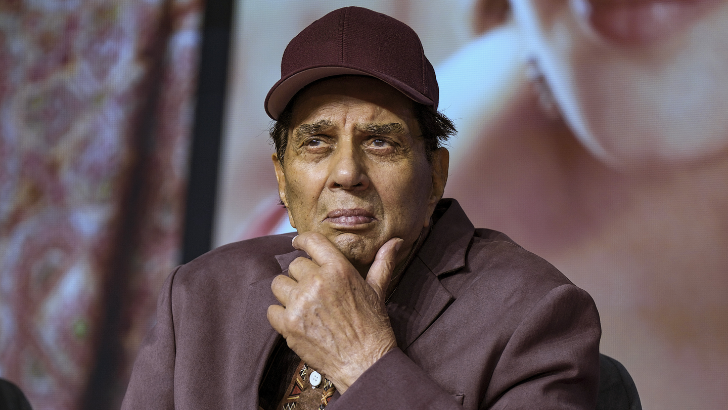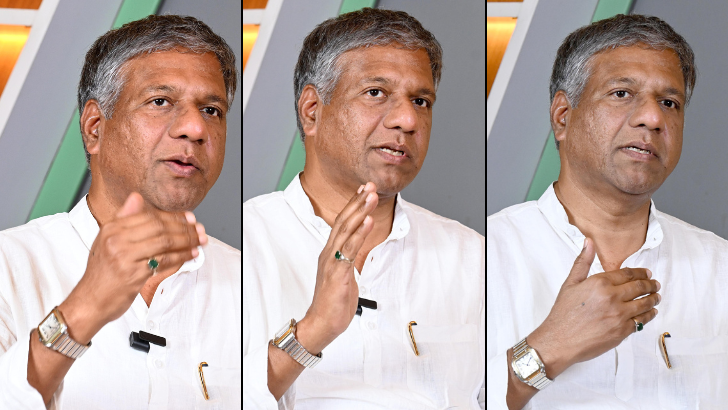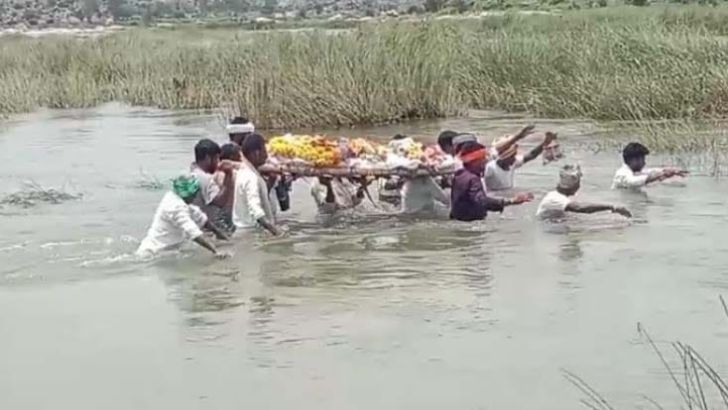The ‘vote theft’ conundrum
EC under fire as Rahul Gandhi’s ‘vote theft’ charge exposes gaps in poll body’s defence and raises tough questions on credibility.
Anushree Chakraborty & Amina Afaq
-
Photo | PTI/ANI
The country is witnessing a political showdown like never before.
It started on 7 August when Congress leader Rahul Gandhi dropped a “bomb” and accused the Election Commission of India of helping the BJP steal votes during the 2024 Parliamentary elections.
Gandhi cited poll data of Mahadevapura in Bengaluru Central parliamentary constituency, and claimed that there were at least 1 lakh manipulated entries. These included duplicate voters, invalid addresses, and numerous voters at a single location.
He said Congress lost at least 48 seats due to this “theft”. Congress won 99 of the 543 seats while the BJP bagged 240.
However, this is not the Congress’ fight alone. Gandhi found support in hundreds of Opposition lawmakers, and they announced a rally in Bihar against the EC, accusing it of not upholding the “one person, one vote” principle of a democracy.
Incidentally, EC held a presser on 17 August, the same day as the rally and aggressively accused the Opposition of making baseless allegations. Chief Election Commissioner Gyanesh Kumar was the man of the hour (though the presser was for 85 minutes) and went through great effort to counter the Oppn’s claims.
However, turns out many of Kumar’s claims crumble under scrutiny. Salar News cuts through the noise to point out some of the discrepancies.
RaGa gets ultimatum, BJP’s Thakur goes scot-free
EC’s narrative
The CEC has given Rahul Gandhi seven days to submit an affidavit regarding his allegations, failing which he must apologise to the nation.
The googly
However, CEC did not make the same demand of NDA leaders such as Anurag Thakur. Anurag had claimed voter theft in 5 Lok Sabha seats and 1 Assembly segment — including Wayanad and Raebareli.
Does RaGa really need to file an affidavit?
EC’s narrative
The CEC has asked Gandhi to sign an affidavit under Rule 20(3)(b) of the Registration of Electors Rules, 1960, within seven days, warning that without it, his claims would be considered baseless.
The googly
However, former CEC OP Rawat has called this demand unnecessary, pointing out that Rule 20(3)(b), which requires claims and objections to be submitted on oath — applies only during an electoral roll revision.. This means that outside of formal revision periods, the registration officer is not obligated to demand an oath or sworn affidavit, and any inquiry into fraudulent or multiple entries can be conducted under other relevant provisions.
Can’t EC probe allegations without affidavit?
According to Section 22 of the Representation of the People Act, 1950, the Electoral Registration Officer (ERO) has the authority to delete or modify any entry in the electoral roll either on an application or on his own motion.
This means that the EC has the power to take suo motu cognisance of allegations or irregularities in the voter list. So, instead of asking Rahul Gandhi to submit a signed certificate or affidavit, why does the EC — an institution responsible for conducting free and fair elections — not act on its own?
Just as any authority must act when a potential crime is reported, the EC too has a responsibility to proactively probe the matter, rather than shifting the burden entirely onto the complainant.
EC’s logic behind not probing ‘vote theft’
EC’s narrative
This is what CEC said, “How can we summon 1.5 lakh voters to the SDM office, make them wait, and accuse them of being fake voters? Won’t the voters ask, ‘What proof do you have?’”
The googly
One wonders why can’t the EC direct Booth Level Officers (BLOs) or SDM officers to conduct door-to-door verification instead of summoning 1.5 lakh people? Why wasn’t this verification done before the polls?
Also, if the EC was able to visit the homes of 8 crore people in Bihar just a few months before the elections, then why can’t a similar action be taken for just 1.5 lakh voters?
EC’s narrative
Gandhi had flagged 30,000 illegal addresses with “House number 0”, “00”, “000”, “-” and “#”. EC said the ‘House number zero’ is assigned to those houses, especially in rural areas, which do not have designated numbers.
The googly
However, when fact-checked by various organisations, it was found that the voters who had house No. zero did not exist.
EC rejects its own guideline on intensive revision
EC’s narrative
In the past, EC has said that it will not conduct an intensive revision of voters in an election year. In 2005, intensive revisions in Arunachal and Maharashtra were stopped and EC refused to allow it in the entire nation.
The googly
So, why is the EC breaking away from its own guideline? EC is hastily conducting SIR in Bihar just 3 months before Assembly elections, that too amid floods. When asked by a scribe, the CEC said that electoral roles should be revised before elections, not after.
1 voter, many votes. But who will prove it?
EC’s narrative
CEC said that some people have multiple voter identity cards due to migration. He also added that just because someone has multiple voter IDs, they cannot cast more than one vote, and asked Opposition to prove if this has happened.
The googly
However, holding more than one voter ID is a crime. So how does EC plan to check this? Also, how does the EC expect parties to prove if such people voted more than once? This requires auditing, which only EC has access to it.
Oppn says EC lying about Bihar SIR
EC’s narrative
CEC claimed that the EC had carried out a Bihar SIR drive in 2003 in a short span of time just like it is doing this year.
The googly
Interestingly, Bihar Opposition parties claimed that in 2003, the EC took a year to complete this exercise.
EC mistaken, Oppn has been flagging discrepancies
EC’s narrative
CEC accused the Opposition parties of not flagging voter discrepancies even though the law allows parties to challenge the election results 45 days after they are declared.
The googly
However, multiple parties have raised objections after Assembly elections such as Haryana, Maharashtra and Delhi, but nothing was done. In fact, Prakash Ambedkar’s Vanchit Bahujan Aghadi also moved the Bombay HC alleging voting irregularities in the Maharashtra elections, but it was dismissed. HC said he was “wasting the court’s time”. Congress wrote a letter to EC on 29 November, 2024, flagging voter discrepancies in Maharashtra, but no action was taken.
Same name, fine. But the same dad’s name?
EC’s narrative
On multiple voters with the same name, CEC cited Piyush Goyal as an example and said India has many people named Piyush.
The googly
However, the “proof” shown by Gandhi shows that people with the same name also have the same father’s name. For example, Gurkirat Singh Dang appears four times in the voter list across booths 116, 124, 125, and 126, but all entries list the father’s name as “Ranbir Singh”.
The CCTV footage conundrum
EC’s narrative
The Opposition demanded CCTV footage from polling booths as the EC had claimed that lakhs of voters turned up in the final hours of polling in Karnataka. Gandhi alleged that a woman named Shakun Rani
had voted twice, as her name appeared twice on the electoral list. Opposition says the only way to verify this is by checking CCTV footage. Opposition also claims that EC has destroyed the footages to cover up.
The googly
EC’s response? Releasing such footage will violate the modesty of “mothers and sisters”.
Did EC wrongly cite SC order?
EC’s narrative
On 8 Aug, the EC replaced digital draft voter lists in Bihar with scanned image versions on its official website — just a day after Rahul’s press conference. Digital draft lists are easier to analyse for errors and large-scale patterns, while scanned images make such analysis significantly harder.
The reason? Citing a 2019 Supreme Court judgment, CEC claimed that the voter list in a machine-readable format cannot be shared with political parties as it would compromise voter privacy.
The googly
However, this interpretation misrepresents the actual SC order. Nowhere does the SC prohibit the sharing of a machine-readable format.
The 2019 judgment states:
"ECI has directed its field-level functionaries to put only the ‘Image PDF’ of the electoral roll in the public domain… It may be added that if the petitioner so wants, he can always convert it into searchable mode which, of course, would require him to put his own efforts."
Additionally, contrary to the EC’s implication, changes cannot be made to machine-readable lists. They merely allow for basic functions such as using the “Ctrl + F” command to search for names, addresses, or EPIC numbers.
CEC says no one filed plaint, Akhilesh says ‘I did’
EC’s narrative
The CEC stated that no political party had filed a complaint about voter theft with an affidavit, and that there was no "voter chori" in the country.
The googly
However, Akhilesh Yadav called out the CEC for "brazenly lying". In 2022, Yadav’s Samajwadi Party had submitted a signed affidavit alleging that 18,000 voters had been illegally deleted in Uttar Pradesh. The EC had even issued an acknowledgment receipt. Yadav shared a copy of the receipt on X too. No action was taken in this case either.
EC’s narrative
When questioned about the Bihar SIR draft roll declaring over 22 lakh people dead in just six months, the CEC claimed that these deaths occurred over the past 20 years but were only now recorded, as earlier revisions didn’t involve door-to-door verification.
The googly
However, the Opposition called this claim ludicrous, arguing that if the voter list used in the last Lok Sabha polls was inaccurate, the House should be dissolved and EC officials, including CEC, held accountable. They questioned how this happened, though revisions of rolls took place every year.
EC says its numbers are ‘fake’
EC’s narrative
EC claimed that the numbers presented by Rahul Gandhi were not theirs, though the voter list was provided by the EC. CEC added Gandhi’s analysis was wrong too.
The googly
The Opposition is now asking if the EC is saying that its own data is inaccurate.
Did BLOs forge signatures in Bihar?
Journalist Ajit Anjum, covering the Bihar SIR, released a video from Phulwari Assembly constituency in Patna showing Booth Level Officers (BLOs) allegedly forging signatures on voter forms.
The Patna district administration dismissed the claims as misleading, stating the BLOs were updating records of deceased or shifted voters by marking "Death" or "Shifted" with their own signatures.
However, Alt News analysed Anjum’s video and found: a male BLO was signing as Shanti Devi, and a female BLO as Chandra Prakash Sah. Anjum also found voter forms lacked addresses, Aadhaar, or EPIC numbers, raising concerns over fake entries. Despite this, rather than launching an inquiry, authorities filed an FIR against Anjum.
Questions EC did not answer
How many electors were added during SIR (25 June-25 July) in Bihar?
If it is true that a leader is spreading falsehoods, don’t you have any authority to take action against them?
After Rahul’s presser, many issues are reported from different states, including Kerala. Will you initiate an inquiry? CEC replied with “Next”.
How did the number of voters increase by 5 crore in Maharashtra?
How come some voters had address and father names as “dfoigoidf”
Invitation to file objections
EC said all eligible electors left out of Bihar’s draft electoral roll published on 1 August, 2025, can file their claim in Form 6, along with a copy of their Aadhaar card, before 1 September. Similarly, if any ineligible elector has been included in the draft roll, any aggrieved elector of that assembly constituency can file objection in Form 7 within the same deadline.
Leave a Reply
Your email address will not be published. Required fields are marked *








.png)



.png)
.png)
.png)

.jpg)

.jpg)
.jpg)
